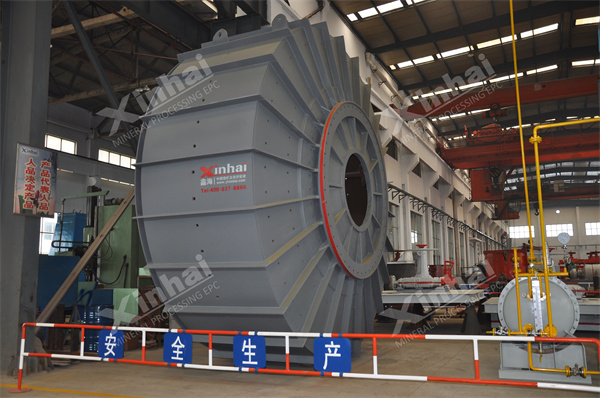Grinding is a crucial operation in the ore beneficiation process, and the Semi-Autogenous Grinding (SAG) mill is widely adopted by many large mines due to its simplified circuit, reduced investment, and streamlined two-stage crushing and screening equipment. This article takes a copper ore processing plant as an example to introduce some methods for enhancing the processing capacity of the SAG mill.
In the copper ore processing plant, which deals with primary sulfide copper ore, the crushing and grinding system adopts a SAG mill + ball mill combination and a cyclone control grading process.

The lower part of the coarse ore bin is equipped with eight electromagnetic vibrating feeders, feeding into a SAG mill through a conveyor. The SAG mill's discharge end has a cylindrical screen, and the screened product returns to the SAG mill via a conveyor.
Two coarse grinding ball mills are each Φ5.03m×8.3m overflow ball mills, driven by 3300 kW low-speed synchronous motors. The SAG mill's screened underflow and the ball mill discharge enter the coarse grinding pump pool. Two 16/14 slurry pumps feed two sets of Φ660mm cyclones, each equipped with 6 cyclones. Generally, 4-5 cyclones are in operation. The cyclone overflow enters the flotation process, and the cyclone underflow is returned to the coarse grinding ball mill for further grinding. The SAG mill feed size is -250mm, and the design discharge size is -2.5mm (P80). The final overflow concentration of the cyclones is 30%-35%, and the grinding fineness is 70%-75%-74μm.
Encountered Problem: After the installation and commissioning of the SAG mill, it was put into trial operation. However, during the two months of trial production, the performance of the SAG mill was subpar. The actual production capacity (250t/h) was only about half of the design capacity (550t/d), and the sand return rate was also very low. Through process investigation, it was found that the undersize from the cylindrical screen was too fine. The plant conducted research in the following areas, ultimately improving the production capacity of the SAG mill.
The particle size and hardness of the ore significantly affect the processing capacity of the SAG mill. The copper ore processed by the plant is divided into two parts: ore from the new mining area and ore from the old mining area. The grindability coefficient of the ore from the old mining area is only 70% of that from the new mining area. When the proportion of ore from the old mining area is high, the production capacity of the SAG mill decreases.
Regarding particle size, obvious particle size segregation occurred when ore from the underground was fed into the coarse ore bin. Different shafts showed different ore size distributions; some were dominated by fines, some were relatively uniform, and others mainly consisted of large ore blocks.
Solution: During ore feeding by electromagnetic vibrators, it is crucial to consider the particle size distribution of each vibrator and the variation in ore hardness. A reasonable match can stabilize the operation of the SAG mill.
Due to the working characteristics of the SAG mill, some tough rocks, also known as hard-to-grind particles or critical particles with a particle size of 25-70mm, are produced during the production process. In simple exploration experiments on the treatment of tough rocks, the ore discharged from the SAG mill was collected and not directly returned to the SAG mill. However, the results showed that a significant amount of tough rocks did not get discharged. Therefore, this measure did not have a noticeable effect on improving the processing capacity of the SAG mill.
Initially, when purchasing grinding balls, the plant considered the large diameter of the mill and had high requirements for the impact resistance of the grinding balls. Therefore, multi-alloy cast steel balls produced by electric furnaces were selected. However, during the shutdown inspection, it was found that this type of cast ball still suffered serious breakage, occupying a considerable filling rate and consuming energy.
Solution: Change the cast steel balls to forged steel balls. The breakage rate of forged steel balls is significantly reduced. Another measure taken is to regularly remove the broken steel balls on the return conveyor, preventing the broken balls from re-entering the circulation, further improving the efficiency of the grinding medium.
The grate plate used in the mill has a profile with a retrograde eight-shaped hole. During use, it was found that this type of grate plate had the disadvantage of poor discharge. The arrangement of retrograde eight-shaped holes was not conducive to the timely discharge of hard-to-grind particles (tough rocks) near the discharge end, resulting in fine discharge granularity and finer sand return granularity.
Solution: To enhance the mill's discharge and improve the processing capacity of the SAG mill, increase the size of the discharge grate plate holes to facilitate the timely discharge of ore. Through these improvements, the processing capacity of the SAG mill was significantly increased, from 250t/h to 350t/h.
During the initial production, 120 tons of balls, including Φ130mm, Φ110mm, Φ90mm, and Φ70mm steel balls, were evenly loaded into the SAG mill at a filling rate of 12%. In the third stage, the SAG mill ensured an actual mixed filling rate of 30%, and the size of the steel balls gradually increased to Φ180mm, achieving stable production. The processing capacity also stabilized at 12,000t/d.
Through these five measures, the process indicators of the SAG mill were greatly improved, and the processing capacity increased to 500t/h, approaching the design processing capacity. The sand return rate of the SAG mill was approximately 15%, and the granularity of the discharge product was significantly improved, with the -74μm content decreasing from 50% to below 30%.